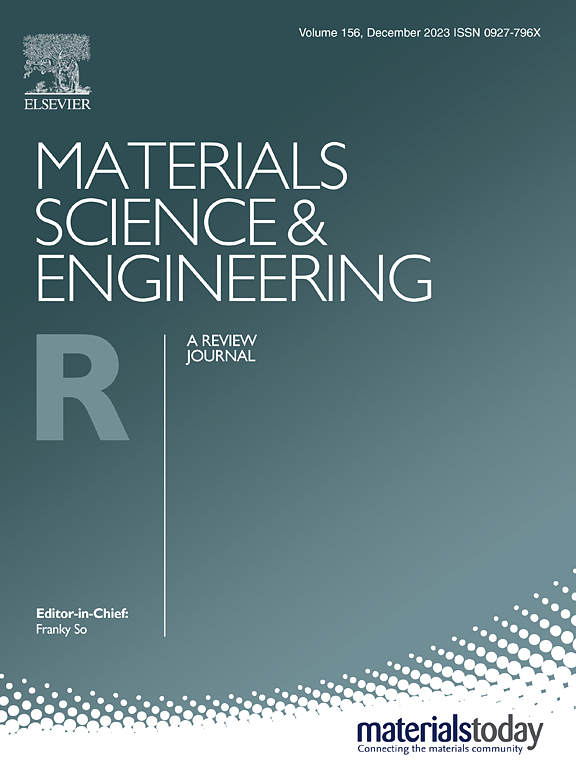Structural, light emitting, and photoelectrical properties of multilayered 2D mixed alloys of gallium monochalcogenides
IF 31.6
1区 材料科学
Q1 MATERIALS SCIENCE, MULTIDISCIPLINARY
引用次数: 0
Abstract
Gallium monochalcogenides (GaX, where X represents Te, Se, or S) have attracted significant attention in the development of 2D semiconductor materials owing to their specific optical and electrical characteristics. Multilayered mixed GaX compounds, ternary alloys of gallium chalcogenides, are mostly direct semiconductors and are considered excellent candidates for wide energy-range light-emitting materials for application in future optoelectronic devices. This review provides a thorough investigation into ternary alloys of gallium monochalcogenides, focusing on the GaTe1−xSex, GaSe1−xSx, and GaTe1−xSx series of layered semiconductor compounds. We provide a comprehensive overview of the methods used to grow these materials, analyze their crystal structures, and characterize their properties. Various growth methods and conditions and their material yields are described. Structural characterization methods reveal detailed information on the composition-driven variations in crystal structure and phase. An optical property analysis reveals the remarkable tunability of their bandgaps and emission spectra, establishing their potential for optoelectronics applications. The light emission range of the GaTe1−xSex series is from near-infrared (NIR) to visible (620–780 nm), while the GaSe1−xSx series emits from the visible to the blue region (478–620 nm) achieving white light. The GaTe1−xSx exhibits the most extensive emission range, spanning from NIR to the blue region (478–780 nm). Furthermore, GaTe1−xSx exhibit high photocatalytic degradation activity for water splitting and organic pollutant degradation. Overall, this review highlights the promising prospects of ternary gallium chalcogenides for advancing future optoelectronics technologies.
多层二维单质镓混合合金的结构、发光和光电特性
镓单质(GaX,其中 X 代表 Te、Se 或 S)因其特殊的光学和电学特性,在二维半导体材料的开发中备受关注。多层混合 GaX 化合物(镓掺杂物的三元合金)大多是直接半导体,被认为是应用于未来光电设备的宽能量范围发光材料的绝佳候选材料。本综述深入研究了镓单质的三元合金,重点是 GaTe1-xSex、GaSe1-xSx 和 GaTe1-xSx 系列层状半导体化合物。我们全面概述了这些材料的生长方法、晶体结构分析及其特性。我们介绍了各种生长方法和条件及其材料产量。结构表征方法揭示了晶体结构和相位由成分驱动变化的详细信息。光学特性分析揭示了它们的带隙和发射光谱的显著可调性,从而确定了它们在光电子学应用方面的潜力。GaTe1-xSex 系列的发光范围从近红外(NIR)到可见光(620-780 nm),而 GaSe1-xSx 系列的发光范围从可见光到蓝光区域(478-620 nm),实现了白光。GaTe1-xSx 的发射范围最广,从近红外一直延伸到蓝光区域(478-780 纳米)。此外,GaTe1-xSx 在水分离和有机污染物降解方面具有很高的光催化降解活性。总之,本综述强调了三元镓瑀化合物在推动未来光电技术发展方面的广阔前景。
本文章由计算机程序翻译,如有差异,请以英文原文为准。
求助全文
约1分钟内获得全文
求助全文
来源期刊

Materials Science and Engineering: R: Reports
工程技术-材料科学:综合
CiteScore
60.50
自引率
0.30%
发文量
19
审稿时长
34 days
期刊介绍:
Materials Science & Engineering R: Reports is a journal that covers a wide range of topics in the field of materials science and engineering. It publishes both experimental and theoretical research papers, providing background information and critical assessments on various topics. The journal aims to publish high-quality and novel research papers and reviews.
The subject areas covered by the journal include Materials Science (General), Electronic Materials, Optical Materials, and Magnetic Materials. In addition to regular issues, the journal also publishes special issues on key themes in the field of materials science, including Energy Materials, Materials for Health, Materials Discovery, Innovation for High Value Manufacturing, and Sustainable Materials development.
 求助内容:
求助内容: 应助结果提醒方式:
应助结果提醒方式:


